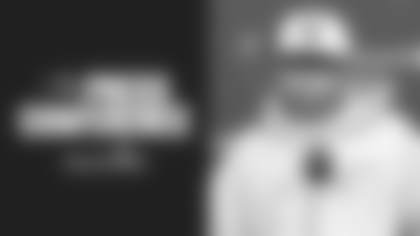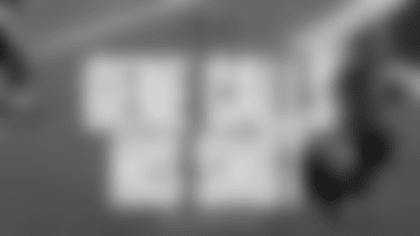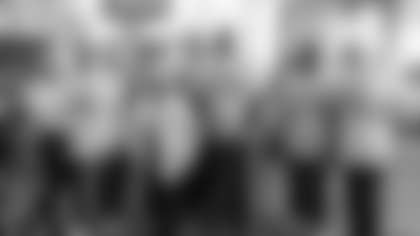RB Earnest Graham helped secure his spot on the Bucs' roster with a series of fine preseason performances
Editor's Note: The following feature is excerpted from *Buccaneers Review, Volume 3, Issue 2. Buccaneers Review is the Tampa Bay Buccaneers' ground-breaking answer to the traditional game program. Buccaneers Review is sold at every Tampa Bay home game and it includes entirely new material, cover to cover, every issue. The magazine-style publication includes exclusive interviews with Buccaneer players and their opponents; in-depth feature stories; a close look at the opponent and their key players; cheerleader features; columns by Head Coach Jon Gruden and long-time Buc standout Dave Moore; rosters, depth charts and much more. In the last issue, Buccaneers Review looked at 10 players, including current starting running back Earnest Graham, who won jobs in the fall by excelling during the preseason. In the wake of undrafted rookie free agent cornerback Elbert Mack securing a spot on the 2008 team with his eye-opening preseason performance, we re-run that feature here on Buccaneers.com.*
For years, Earnest Graham carried around the nickname, "Mr. August."
Now, the title wasn't exactly a putdown, but all the same it wasn't one he would have chosen for himself. In essence, the nickname said that his preseason statistics tended to be much more impressive than what he put up once the games started to count.
But here's the thing: Graham may not have been "Mr. October" (or "Mr. January," as might be more appropriate for the NFL), but he was around in October. And January. And every month in between. Earnest Graham arrived in Tampa as an undrafted free agent in 2003 and, save for the first half of his rookie season when he was off the roster recovering from an injury, he's been there ever since. Why? Well, those annual preseason eruptions had something to do with it.
From 2004 through 2006, in 12 preseason games, Graham carried the ball 110 times for 443 yards, caught 14 passes for 147 yards and scored a combined eight touchdowns. In that same span, over 41 regular season games, he posted 52 carries for 215 yards and one reception for four yards, with nary a touchdown.
The key stat in that latter group is 41 games. With the likes of Michael Pittman, Mike Alstott and Cadillac Williams in front of him, Graham didn't get many opportunities in the backfield once the regular season began, but he had proven himself to be an extremely valuable player on kick coverage and even kickoff return, and thus his roster spot remained secure. Unlike cornerbacks or linebackers, however, running backs rarely make the 53-man roster on their special teams contributions alone. It's safe to say that his preseason exploits on offense were Graham's ticket to October.
That's the type of player we're looking for here.
Some veterans come to training camp with their roster spots all but secured, and some high-round draft picks are ticketed for the regular season no matter how productive they are in August. But each summer there are many more men in the middle, players who head into the preseason needing to win a job. Below are nine more players, in addition to Graham, who did just that.
A note: Here we're only worried about the first half of the story. Graham not only rode his preseason performances into a satisfying, multi-year career in the NFL but even got his chance in the backfield in 2007 and is now the starting tailback heading into '08. The second half of his story has gone well, but that's not necessarily the case for every shining light of August.
Some players, including a few on the list below, weren't as fortunate. Injuries or the vagaries of the depth chart kept them from showing the same NFL staying power as Graham. The point, however, is that they got a shot on Sundays…all because of what they were able to do on Saturday nights in August.
And wait…one more note: This is not a "best of" list or, likely, even an exhaustive one. Have other Buccaneer unknowns emerged out of obscurity during the 33 years worth of August dog days in team history? It's almost certain. But these are nine other players in addition to Graham who might be of special interest to Tampa Bay fans.
1. Husted Kicks the Competition (1993)
In 1992, Sam Wyche's first year at the helm, the Bucs lost reliable kicker Steve Christie in a free agency miscalculation during the offseason and thus went into camp hoping young kicker Ken Willis could handle the job. It took nine games for the Buccaneers to abandon that plan – Willis was eight of 14 on field goal tries but only five of 11 from beyond 29 yards – and go the veteran pickup route with much-traveled leg Eddie Murray.
Murray handled the placekicking duties for the last half of the '92 season and was perhaps nominally better, but obviously not a long-term solution. Still, he came into Tampa Bay's 1993 camp as the incumbent and the favorite to win the job again. The Bucs auditioned seven other kickers at various times and eventually brought four of them to training camp.
The challenger? Well, that would be Daron Alcorn. For the first time in eight years (Donald Igwebuike, 10th round, 1985), the Buccaneers used a draft pick on a placekicker, tabbing Akron's Alcorn (say that three times fast) in the eighth round. Alcorn was supposed to be a rare dual challenger at both punter and placekicker, but the Bucs found him to be "erratic" in the preseason. Instead, their attention was drawn to Michael Husted, a rookie free agent out of Maryland who not only handled his audition kicks calmly but also displayed a strong leg on kickoffs.
It was obvious who was leading the race when the games began and Husted was given eight of the nine field goal attempts and four of the eight extra point tries. Alcorn and fellow free agent Tracy Bennett went first, and then Husted won the job from Murray with two field goals and three touchbacks in the third preseason game against Buffalo. Coincidentally, Christie was kicking for the Bills in that game, and he congratulated his successor after the game.
"We think [Husted] will have a long career, like Jim Breech and Eddie Murray," said Wyche, proving prescient. Husted lasted six seasons in Tampa and left as the team's all-time leading scorer, though he was eventually surpassed by Martin Gramatica.
In his debut season, Husted made 16 of 22 field goals, including three from 50 yards or farther, all on the rookie minimum salary of $100,000. That was plenty for Husted. "I'd do this for $15,000 or $20,000," he said after winning the competition.
2. Ivy Climbs up the Ranks (2001)
Cornerback Corey Ivy had an interesting resume before he arrived in Tampa in 2001, but not one that necessarily portended a long NFL career. He had been an Enforcer (XFL's Chicago team) and a Galaxy (Frankfurt in NFL Europe) but his NFL attempts in New England and Cleveland in 1999 and 2000, respectively, hadn't gone far. Ivy was a tenacious competitor, but small and not blessed with the type of skills that had scouts buzzing.
The Bucs thought Ivy could excel on special teams, at least, and sure enough in his very first appearance in pewter and red he racked up a pair of kick-coverage tackles against Miami. In fact, he stopped return man Chris Chambers on the game's opening kickoff. At the end of the four-game preseason slate, Ivy was the Bucs' leading special teams tackler, with five stops.
But Ivy got his chance on defense in the preseason, too, and made the most of it. He finished second on the team with 11 solo tackles and also snared an interception and broke up two passes. He picked off Patriots QB Damon Huard in the fourth quarter of the third preseason game, and that helped buy him extended action in the preseason finale, when starters typically rest and young players jockey for the last snaps of their collective audition. Against Atlanta, Ivy used that playing time to rack up seven tackles and a pass defensed.
It actually took the Buccaneers a few weeks to get Ivy onto the roster once the regular season began, as they initially put him on the practice squad. He didn't play an enormous amount in 2001, but stuck around long enough to emerge as a kicking-game force in 2002. That season, as the Bucs rolled all the way to the Super Bowl XXXVII title, Ivy was named the team's special teams MVP.
3. Hagins Ensures His Return (1976)
If not for a fluky separated shoulder on the opening kickoff of the first regular-season game in Buccaneers history, the infamous kickoff-return drought that plagued the franchise for 32 years might have been avoided altogether.
Tampa Bay fans who watched their new team sort things out in the preseason of 1976 would never have guessed that kickoff return would be the team's black hole, given the exciting work of rookie receiver Isaac Hagins. In four preseason games, Hagins returned a pair of kickoffs for touchdowns, one 92 yards against Chicago and the other 102 yards versus Cincinnati. It was exactly the sort of performance a young and unknown player needed to put together in order to get his foot in the NFL's door.
Hagins had actually been drafted by the Vikings in the ninth round out of Southern, but had been released early in training camp. The Bucs, obviously searching everywhere for talent in those difficult early expansion years, snapped Hagins up and gave him a try in the return game. He was an immediate hit, obviously.
Actually, Hagins didn't get his chance in the return game until the fourth preseason game, after the Bucs had tried out such wildly memorable options as Manfred Moore, Don Westbrook and Joe Wylie. Even in that game, Hagins wasn't used until the second half. But the first time he touched the ball as a Buccaneer he went the distance, and by opening day he was the man deep for the franchise's very first regulation kickoff.
Unfortunately, Hagins was hit with the aforementioned shoulder injury in that very game and was lost for the season. He would return in 1977 and play for four more seasons, however, proving to be a decent complementary receiver as well as a return man. In 1979, Hagins caught a career-high 39 passes for 692 yards and two touchdowns as the Bucs won the NFC Central for the first time.
4. Golsteyn Overthrows Thompson (1983)
When a series of questionable decisions left the Bucs essentially without a starting quarterback heading into the 1983 offseason, the team decided it would be a good idea to send their 1984 first-round pick to Cincinnati for the rights to Jack Thompson. Though he was the third overall pick in the 1979 draft, Thompson wasn't exactly one of the league's brightest lights by 1983.
Thompson had struggled to fulfill his potential in Cincinnati and never did replace aging starter Ken Anderson. By 1982, he had left the team in a dispute, so it's safe to say the Bengals were thrilled to get a first-round pick in return, particularly when that proved to be the first overall pick in 1984 (which the Bengals eventually traded to New England).
Still, Thompson had the pedigree and in Tampa he had to beat out only the likes of Bob Hewko, Jeff Quinn…and Jerry Golsteyn, who was described in that year's Buccaneers media guide as a "rags-to-riches story."
Before signing with the Bucs in 1982, Golsteyn had been out of the NFL for nearly three years and had most recently played with the Orlando Americans of the American Football Association. He had first entered the league as a 12th-round draft of the Giants in 1976 and had played in a total of 15 games with three starts in his first four seasons.
Thompson started the first three preseason games, but Golsteyn consistently outplayed him once he got into the game. Golsteyn finished the preseason with excellent numbers (40 of 66 for 474 yards, three touchdowns and one interception) and in the finale the Bucs relented and gave him the start. When he led the Bucs to a 41-21 win over New England to cap a 4-0 preseason, Golsteyn had won the starting job going into the regular season.
Unfortunately for Golsteyn, it wouldn't last. He started only the first two games, and though his numbers weren't horrible (36 of 63 for 397 yards and one interception), the Bucs were 0-2 and had scored just 10 points. Thompson got the call and held onto the job for the rest of the season.
5. Yo, Kid, You Got the Job! (1999)
When the Buccaneers exited the preseason with their 53-man roster in 1999, they would do so with four returning contributors at receiver – Jacquez Green, Reidel Anthony, Bert Emanuel and Karl Williams – and two kids who had come out of nowhere.
The fifth and sixth receiver spots at the start of '99 went to Darnell McDonald and Yo Murphy, a rookie and a first-year player, respectively. At least McDonald had the distinction of being a Buccaneer draft pick that year, albeit a seventh-rounder. Murphy was an undrafted free agent out of Idaho with the Vikings in 1998 who had signed with the Buccaneers just days before their 1999 camp.
Tampa Bay's coaches let the young kids play, and they did well, helping the Bucs rack up 237 gross passing yards per game during an impressive 4-0 preseason. McDonald snared 10 passes for 151 yards and a touchdown while Murphy turned six catches into 100 yards (16.7 ypc). The clincher for Murphy, however, came in the third quarter of the preseason's third game, a 45-14 domination of the Patriots.
On the only kickoff he would field during the entire preseason, Murphy went the distance. He fielded the ball at the Bucs' seven, dashed to the left sideline and outran the Patriots to the far end zone. Murphy would eventually play in seven regular season games as a Buccaneer, returning 14 kickoffs at a 21.9-yard clip.
History nearly repeated itself three years later when another bubble player named Murphy almost secured a spot with a kickoff return touchdown. This time it was Frank Murphy, who got Jon Gruden's tenure started off right in 2002 by returning the first kickoff of the first preseason game 95 yards for a touchdown. Murphy did not make the team in 2002, however, though he had seen action in 2000 and 2001 and would return for a brief stint in 2004.
6. Quarles Pumps Up Q-Rating (1997)
It's strange to think of it now, after he spent a decade at the center of one of the most dominant defenses in modern NFL history, but there was a time when linebacker Shelton Quarles was well out on the prospect fringe.
Quarles had his first crack at the league as an undrafted free agent out of Vanderbilt with the Miami Dolphins in 1995. By his own admission, he was too cocky in his first camp, and he was shocked when the Dolphins let him go. From there, he bounced to the Canadian Football League and even spent time out of the game, working at a printing press in Tennessee.
But Bucs Pro Scout Mark Dominik (now the team's Pro Personnel Director) found Quarles on some CFL tape and thought he saw an NFL-caliber combination of speed and size. Quarles came to training camp with the Buccaneers in the summer of 1997 with no fanfare, but Dominik and the Bucs' scouts thought he could make it on special teams.
Quarles proved that thought right almost immediately in training camp. During the preseason games, however, the Bucs discovered that their new linebacker might also be a candidate for the starting lineup at some point. Quarles played in every game, finished third on the team with 11 tackles, added a tackle for loss and a pass defensed and also made two kick-coverage stops. He also made the 53-man roster, and was an instant hit on special teams. By 1999 he was starting at strongside linebacker and by 2002 he was a Pro Bowler and a Super Bowl champ in the middle.
7. Stecker Brings European Success to the States (2000)
Aaron Stecker did it all in the summer of 2000, but mostly he scored touchdowns.
The Western Illinois product had signed with the closest NFL team, the Bears, after going undrafted in 1999, but didn't stick around past the preseason. The Bucs picked up Stecker for their practice squad late in the season and thought he might be a good candidate for the NFL Europe League.
That idea worked out rather well. All Stecker did with the Scottish Claymores was rush for 774 yards, pick up more than 1,000 yards from scrimmage and earn the league's Offensive MVP honors.
Still, the NFL landscape is littered with former NFL Europe standouts who never translated that success to the top level. Stecker proved to be a happy exception. He reported to the Bucs' training camp in 2000 determined to do whatever it took to stick.
"I have to make plays," said Stecker on the cusp of his first NFL season. "I have to take advantage of every opportunity, whether it's chasing a guy and making a tackle, returning kickoffs, playing special teams or running the ball."
Stecker made an immediate impression in the preseason opener against Washington when he ran the length of the field to chase down linebacker Eddie Mason after an interception, preventing a touchdown. Before the preseason was over, he would rack up five tackles and a fumble recovery on special teams, return a kickoff of his own 78 yards, rush for 47 yards and three touchdowns and catch five passes. He was the team's leading TD producer in the preseason.
Stecker went on to play four very good seasons in Tampa, including the Super Bowl year, and he is still a valuable contributor in New Orleans as the 2008 season approaches.
8. Harvey Beats Out the Pack (1990)
The Buccaneers drafted Tennessee's Reggie Cobb high in the second round in 1990, and it was clear he was going to be the team's primary ballcarrier. Still, there were plenty of other candidates to fill out the running backs meeting room, including former San Diego star Gary Anderson, who had cost the team second and third-round picks in a trade.
In addition, the Bucs' two-headed rushing tandem from the previous two years, Lars Tate and William Howard, were still on hand. Fullback Bruce Perkins even got some carries.
And then there was dark horse candidate John Harvey, a slight 200-pound back who had first try to hook on with the team as an undrafted free agent out of UTEP the year before. Harvey had gained 87 yards on 24 carries during the summer of '89, only to be sent away on the final roster cut. Obviously, he intended to do even more in his second go-around.
Still, Harvey was nearly forgotten when the 2000 preseason started. Eleven different players accounted for the Bucs' 35 carries in a preseason-opening win over Cincinnati, and Harvey got only one of them. The next two games, he didn't get even a single carry. So when the chance to play extensively in the final preseason game against the Jets was presented, he jumped all over it.
In a 23-14 Bucs win, Harvey carried 13 times for 71 yards and caught two passes for 14 yards. The team was convinced, and a few days later cut both Howard and Tate to keep a spot for Harvey. He would go on to play in all 16 games, make one start, rush for 113 yards with a 4.2-yard per-carry average and catch 11 passes for 86 yards and a score.
9. Chamblee Turns It Up a Notch (1992)
The Buccaneers actually drafted Virginia Tech linebacker Al Chamblee in 1991, and he made the team for the second half of his rookie campaign. Still, he was by no means a lock for the roster when training camp rolled around the following summer.
For one thing, the Bucs had a new coaching staff with Sam Wyche at the helm, and they had just imported five new defenders in their own system's mold in the 1992 draft. In addition, Chamblee was still considered a bit of a 'tweener. He played defensive end at Clemson but at 6-1 and 250 pounds looked more like a linebacker to NFL scouts. The Bucs had drafted him with that position in mind, only to move him back to end when they finally played him in 1991.
And finally, Chamblee was far from an established part of the roster at that point. He was a 12th-round pick in '91 and he had spent the first half of his rookie season on the practice squad. After he was promoted, he turned in just one sack in nine games.
So Chamblee set about to prove that he could play defensive end in the NFL, and did so in the best way possible – racking up quarterback sacks in the preseason. In just four August games he would post a team-leading four sacks, including at least one in each of the first three games. He also added nine tackles and caused a fumble. His two-sack performance at Miami essentially clinched his spot on the regular-season roster.
Chamblee made a small impact during the regular season, too, appearing in 13 games with three starts and contributing 15 tackles and a sack. He would not return in 1993. Still, that one month in the summer of 1992 represented his best body of work as a pro and it helped keep him in the league for another year.
























